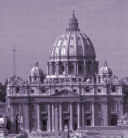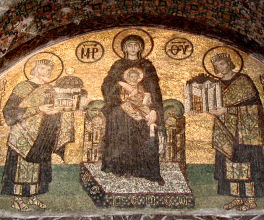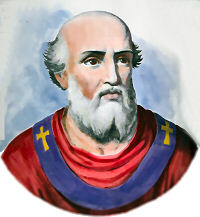Easter: May 18th
Thursday of the Sixth Week of Easter or Solemnity of the Ascension (for certain ecclesiastical provinces); Optional Memorial of St. John I, Pope and Martyr
» Enjoy our Liturgical Seasons series of e-books!
In the United States, the ecclesiastical provinces of Boston, Hartford, New York, Newark, Omaha, and Philadelphia have retained the celebration of the Solemnity of the Ascension on the proper Thursday while all other provinces have transferred this solemnity to the Seventh Sunday of Easter, May 21. If transferred to Sunday, today is observed as the Optional Memorial of St. John I, Pope.
Today marks the beginning of the Pentecost Novena to the Holy Spirit, honoring the original novena (9 days of prayer) of the Apostles and Mary, awaiting the promised coming of the Paraclete. Catholic Culture has several versions to use. We also highly recommend this 10-Day Devotion to the Holy Spirit from the St. Josemaria Institute, taken from The Handbook of Prayers. The actual timespan between Ascension Thursday and Pentecost is 10 days, so you can choose a 9 or 10 day devotion. If you choose a 9-day devotion, end a day early or start Friday after Ascension Thursday.
Pope St. John I (d. 526) was elected Pope in 523. The Arian King Theodoric sent him as his ambassador to Emperor Justin in Constantinople. On John I's return, he was captured by the king, who was displeased at the outcome of the embassy and cast him into prison at Ravenna where he died a few days later. As pope he was responsible for introducing the Alexandrian computation of the date of Easter; it came to be accepted throughout the West.
 Ascension Thursday
Ascension Thursday
Station with San Pietro in Vaticano (St. Peter's in the Vatican):
For the solemnity of the Ascension, we return again to St. Peter's in the Vatican. Here we join Peter and the other apostles watching Jesus ascend triumphantly into heaven. The Church acclaims Him in His holy humanity, invited to sit on the Father's right hand and to share His glory. But Christ's Ascension is the pledge of our own. Filled with an immense hope, the Church looks up towards her leader, who precedes her into the heavenly home and takes her with Him in His own person. The whole life of the Church is placed between our Lord's Ascension and His return on the last day. Confident that she does not wait in vain, she preaches His Gospel and spreads His grace everywhere until the day when He returns in all His Father's glory for those whom He came down to earth to snatch from Satan's power.
For more on San Pietro in Vaticano, see:
For further information on the Station Churches, see The Stational Church.
St. John I
This Tuscan was destined to be glorified not only during his lifetime but after his death as well. Although peace with the East had been restored, a suspicious Theodoric grumbled in his castle at Ravenna. An Arian, the king saw the new friendliness between East and West as a serious threat to his reign. To further alarm him, Emperor Justin had reinstated the laws against heretics, Arians included, and had embarked on a campaign of confiscating churches and excluding heretics from public office, causing many Arians to abandon their faith. Infuriated, Theodoric summoned John to Ravenna and ordered him to head a delegation to the orthodox emperor to ask that the persecution stop and allow forced converts to return to Arianism. At first John refused, then fearing that the king's wrath would be taken out on Western Catholics, he agreed to do Theodoric's bidding on every count save one. He boldly told the king that he would not ask the emperor to allow converts to return to heresy.
The pope arrived in Constantinople shortly before Easter in 526, and since he was the first pope to leave Italy, his reception was more than he could have dreamed. He had been met by the entire city at the twelfth milestone, where the clergy led the procession carrying candles and crosses, and even the emperor prostrated himself before the Holy Father.  The day of Easter, John was seated in a throne higher than the one occupied by the patriarch, in the church of Sancta Sophia, where he celebrated Mass in the Latin tradition. John was accorded the highest honor when he placed the customary Easter crown on the head of Emperor Justin.
The day of Easter, John was seated in a throne higher than the one occupied by the patriarch, in the church of Sancta Sophia, where he celebrated Mass in the Latin tradition. John was accorded the highest honor when he placed the customary Easter crown on the head of Emperor Justin.
After meeting with Justin on Theodoric's behalf, the pope made the exhausting trip back to Ravenna. The king's fury raged. Jealous of the pope's grand reception in the East, Theodoric accused the pope of failing his mission by not securing all of the demands put to Justin. The king then ordered John to remain in Ravenna at his disposal. The aged pope was spent; the prospects before him were dismal. Already ailing, Pope John died and was hastily buried outside the castle walls. Pope John's body was exhumed and on May 27, 526, was returned to Rome and placed in the nave of St. Peter's.
—Excerpted from The Popes: A Papal History, J.V. Bartlett
Highlights and Things to Do:
- The Church has had a long, unbroken line of popes. Have your children answer the following questions: How many popes has the Church had? How many popes are honored with the title of saint, blessed or venerable? Which pope reigned longest? Which three names have been chosen most frequently by popes? You can check this page to help get the answers.
- Pray especially for the Holy Father today. Pray a type of the Morning Offering in which we pray for the Holy Father's intentions.
- Read more about Pope St. John I:
- Pope John is buried in St. Peter's Basilica.








